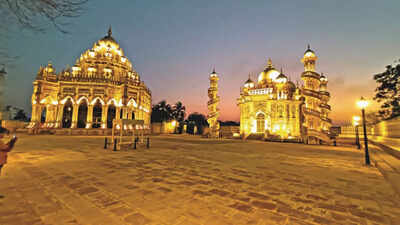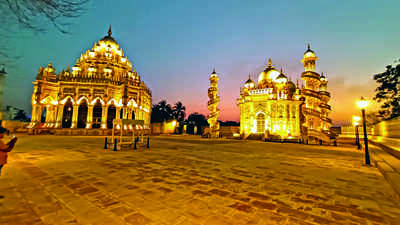- News
- City News
- rajkot News
- Junagadh’s 19th century tombs reclaim original glory
Junagadh’s 19th century tombs reclaim original glory
RAJKOT: For years, this architectural marvel in Junagadh was covered in dust, its windows shattered and several parts corroded. Tourists visiting Asatic lion’s last abode Gir in the district or those going to Girnar temple seldom evinced interest seeing these structures that stand right in the middle of this town.
But these iconic structures - mausoleums of Junagadh’s erstwhile ruler Nawab Mahabat Khan II and his vazir Bahauddin Hussain Bhar- built in 1892 and 1896 respectively - have been restored to their original glory.
What makes the restoration even more interesting is the use of the same method that was adopted about 150 years ago to build these mausoleums. The tourism department had started the restoration work two years back at the cost of Rs 7 crore and it’s on the verge of completion. The restoration is expected to add a glittering attraction in Junagadh along with Asiatic lions, Girnar ropeway as well as the Somnath temple which is a favourite tourism circuit of visitors. Kuldeep Paghdar, assistant engineer of tourism department in Junagadh said, “We first surveyed what kind of design and material was used originally and then used the same material and otho dongo method in the restoration process. In Saurashtra region, this method was prevalent then and in many structures of limestone, this method of construction was used.”
According to Paghdar, no cement is used in restoration and only natural material like limestone is used. In ancient times, mixing the binding material was done in a chakki, which was adopted in restoration too.
Praduman Khachar, professor of history in Junagadh, said “An architect named Jetha Bhaga Mistry had designed the two tombs and the Bahauddin College. Limestone was easily available in the coastal parts of Saurashtra and it was commonly used in many constructions at that time.”
Several parts of the tomb, which is flanked by minarets, like railing, domes on windows, flower pots, balcony, grills and others were corroded but restored using the original design.
These tombs are a witness to the bitter revolt that was triggered by the Nawab’s decision to join Pakistan during the partition in 1947.
But these iconic structures - mausoleums of Junagadh’s erstwhile ruler Nawab Mahabat Khan II and his vazir Bahauddin Hussain Bhar- built in 1892 and 1896 respectively - have been restored to their original glory.
What makes the restoration even more interesting is the use of the same method that was adopted about 150 years ago to build these mausoleums. The tourism department had started the restoration work two years back at the cost of Rs 7 crore and it’s on the verge of completion. The restoration is expected to add a glittering attraction in Junagadh along with Asiatic lions, Girnar ropeway as well as the Somnath temple which is a favourite tourism circuit of visitors. Kuldeep Paghdar, assistant engineer of tourism department in Junagadh said, “We first surveyed what kind of design and material was used originally and then used the same material and otho dongo method in the restoration process. In Saurashtra region, this method was prevalent then and in many structures of limestone, this method of construction was used.”
According to Paghdar, no cement is used in restoration and only natural material like limestone is used. In ancient times, mixing the binding material was done in a chakki, which was adopted in restoration too.
Praduman Khachar, professor of history in Junagadh, said “An architect named Jetha Bhaga Mistry had designed the two tombs and the Bahauddin College. Limestone was easily available in the coastal parts of Saurashtra and it was commonly used in many constructions at that time.”
Several parts of the tomb, which is flanked by minarets, like railing, domes on windows, flower pots, balcony, grills and others were corroded but restored using the original design.
These tombs are a witness to the bitter revolt that was triggered by the Nawab’s decision to join Pakistan during the partition in 1947.
FOLLOW US ON SOCIAL MEDIA
FacebookTwitterInstagramKOO APPYOUTUBE

Start a Conversation
end of article











